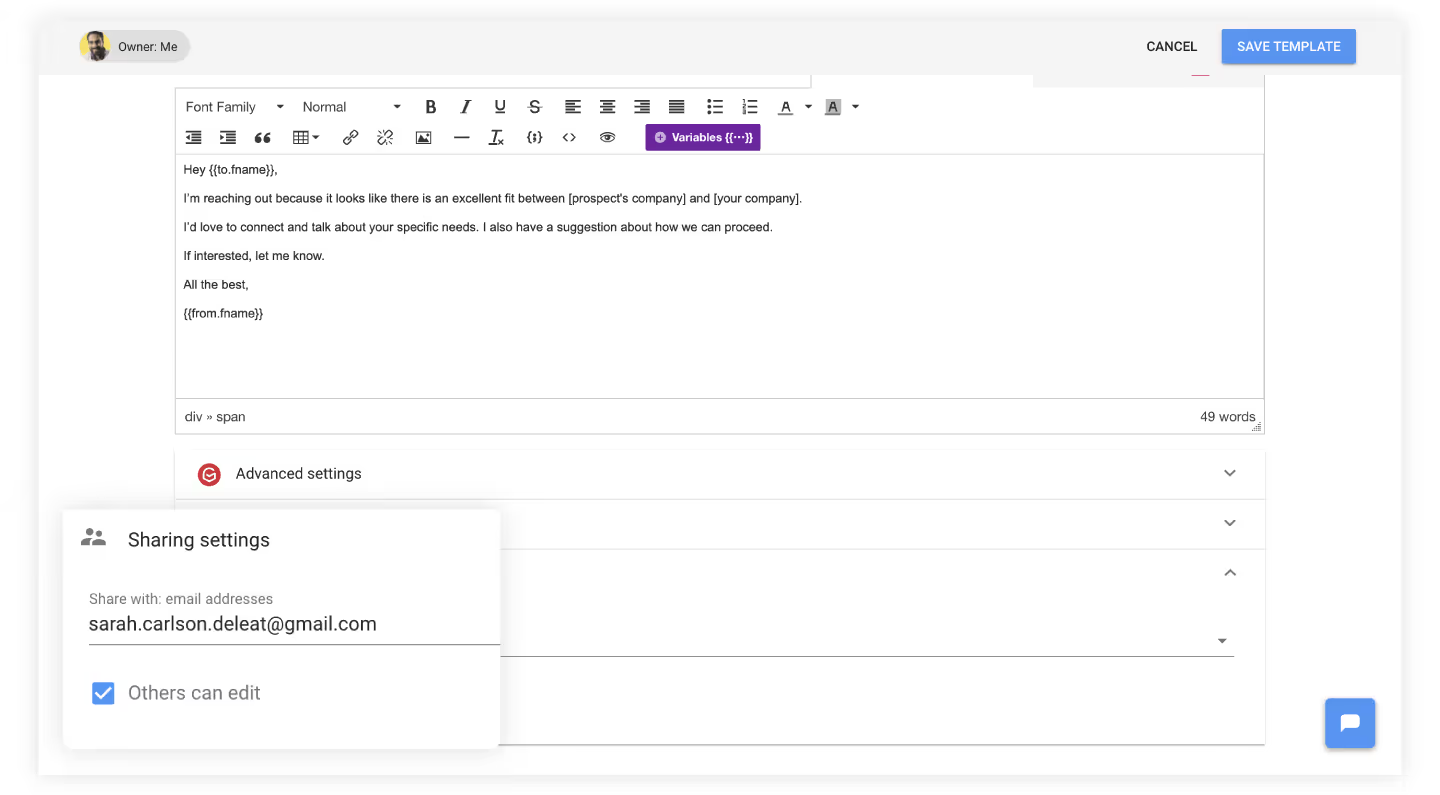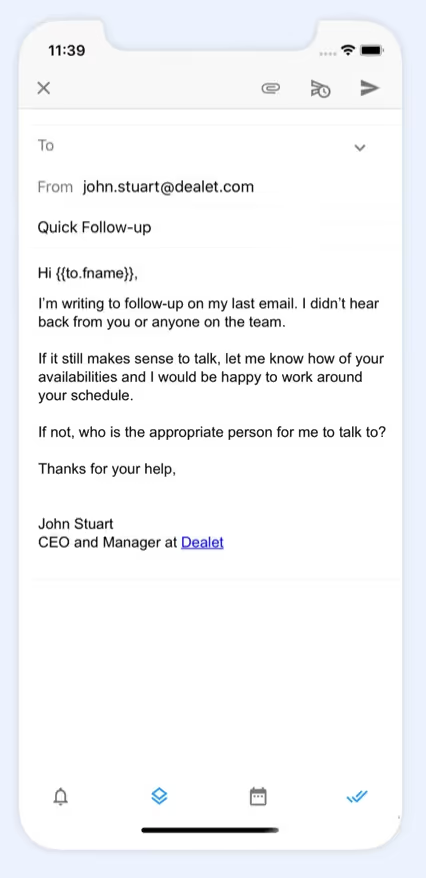Les modèles d'e-mails sont l'un des principaux moyens de gagner du temps gestion des e-mails. D'un simple clic, vous obtenez un e-mail entièrement rédigé dans votre fenêtre de rédaction, prêt à être utilisé.
En prenant le temps de créer des modèles d'e-mails, vous pouvez améliorer considérablement l'efficacité de votre communication et gagner un temps précieux.
Et une seule chose pourrait améliorer les modèles d'e-mails ? Personnalisation.
Vos modèles d'e-mails passeront de froids à chauds lorsque vous les personnaliserez. Ajoutez quelques informations auxquelles votre destinataire se rapportera et les résultats suivront.
Quels sont les avantages de l'utilisation d'e-mails personnalisés ?
- Les e-mails dont l'objet est personnalisé ont 26 % plus de chances d'être ouverts.
- Les e-mails personnalisés génèrent des taux de transaction 6 fois plus élevés.
- Taux de clics uniques 41 % plus élevés.
- Taux d'ouverture uniques supérieurs de 29 %.
Source : socialmediatoday.com
En supposant que vous soyez convaincu de l'augmentation des taux d'ouverture, de l'engagement et, en fin de compte, des revenus, votre prochaine question est probablement de le faire lorsque vous devez envoyer une tonne d'e-mails par jour ?
Mais attendez, que sont les modèles d'e-mails dans Gmail ?
Modèles Gmail sont simplement des e-mails préécrits auxquels vous pouvez accéder facilement, modifier rapidement et envoyer en un clic.
Création d'une bibliothèque de modèles dans Gmail vous facilitera la vie, maintiendra la cohérence de la marque, y compris le style et le ton de la voix.
Les modèles d'e-mails Gmail constituent des structures de base pour rédiger des messages, faciliter la collaboration en équipe et améliorer l'efficacité organisationnelle.
Les modèles peuvent être utilisés pour toutes sortes de messages répétitifs tels que :
- E-mails de bienvenue
- Sensibilisation au froid
- Suivi des ventes
- Demandes fréquentes des clients
- Communications internes à l'équipe
- E-mails de confirmation
- Demandes d'informations
- Marketing par e-mail
- Et bien d'autres encore...
Pourquoi utiliser (et partager) des modèles Gmail ?
« Les modèles Gmail sont mes préférés. Ils me permettent de créer rapidement des e-mails de bienvenue, des réponses commerciales et des demandes de tâches pour les clients avec l'assurance qu'ils seront envoyés dans la boîte de réception et non dans le dossier des spams ou des promotions. »
- Brian Childers, fondateur et PDG de Foxxr Digital Marketing
Bien que la création de modèles d'e-mail dans Gmail s'avérera être un véritable gain de temps, partage ces modèles vous permettent de passer au niveau supérieur. Par partage d'e-mails modèles avec les membres de votre équipe, vous améliorerez à la fois les performances de votre équipe et la stratégie de communication en général en proposant enfin à votre organisation une bibliothèque pour ses modèles d'e-mails.
3 avantages du partage de modèles d'e-mails
- Cela augmente la productivité de votre équipe en économisant du temps, afin que l'on puisse se concentrer sur des sujets plus importants tâches.
- Il garantit communications cohérentes avec un solide portefeuille de contenus approuvés, utiles et attrayants. L'utilisation d'un modèle enregistré garantit que votre équipe maintient une communication cohérente avec les clients et les parties prenantes internes.
- Il permet à votre équipe d'évaluer clairement les processus et amplifier leur stratégie de sensibilisation.
Tout cela et bien plus encore peuvent être réalisés dans Gmail à l'aide de Gmelius. La création d'un modèle d'e-mail hautement personnalisé et son partage avec votre équipe peuvent se faire en trois étapes rapides.
Comment créer un nouveau modèle d'e-mail ou une réponse standard dans Gmail ?
Il existe plusieurs manières de créer un nouveau modèle d'e-mail dans Gmail. Vous pouvez mettre à jour les paramètres de votre compte Gmail afin de activer les modèles, ou vous pouvez utiliser une extension Chrome telle que Gmelius pour gérer les modèles et enregistrer les brouillons en tant que nouveau modèle. Gmail vous permet d'enregistrer des modèles et d'utiliser certaines fonctionnalités de base telles que les champs dynamiques, mais vous pouvez faire bien plus encore. Lisez la suite pour découvrir comment Gmelius enrichit vos modèles avec des fonctionnalités avancées.
À l'aide de Gmelius, vous pouvez rédiger un nouvel e-mail et l'enregistrer en tant que modèle directement depuis la fenêtre de rédaction en cliquant sur « Créer un modèle », ou vous pouvez créer et gérer vos modèles Gmail depuis votre tableau de bord Gmelius.
Pour enregistrer un brouillon en tant que modèle, accédez à l'icône Plus d'options et sélectionnez le menu Modèles.
Pour insérer un modèle lors de la création d'un nouvel e-mail, cliquez simplement sur l'icône « Insérer un modèle/une séquence » en bas de la fenêtre de votre message Gmail, accédez à l'onglet Modèles et sélectionnez simplement le modèle de votre choix. Son contenu sera inséré immédiatement.
Après avoir rédigé votre e-mail, cliquez sur Enregistrer pour finaliser votre nouveau modèle.

Vous pouvez utiliser vos modèles comme bibliothèque de réponses prédéfinies. Cela vous fera gagner beaucoup de temps et vous évitera de taper la même réponse encore et encore. Cela peut être un excellent moyen de s'améliorer temps de réponse. Une équipe de garantie peut facilement créer des modèles pour les demandes de produits, ou une équipe de recrutement peut répondre rapidement aux candidats à chaque étape du processus d'entretien.
Une astuce puissante consiste à créer des réponses prédéfinies avec des variables dynamiques pour une touche personnalisée. En utilisant variables personnalisées dans les modèles Gmail, vous bénéficierez de taux d'ouverture et d'engagement plus élevés. Ces KPI seront encore plus importants à suivre pour les équipes commerciales qui font de la prospection à froid ou qui réengagent les clients.
Voici comment insérer des variables dynamiques lors de la création d'un modèle d'e-mail dans le tableau de bord Gmelius.

« Je dois dire que ce que j'aime le plus chez Gmelius, ce sont les modèles. Gmelius autorise les variables et pas seulement celles créées par Gmelius, mais celles que l'utilisateur peut également créer. »
Comment modifier vos modèles d'e-mails pour Gmail ?
Lorsque vous insérez un modèle dans l'un de vos e-mails, vous souhaiterez peut-être parfois modifier légèrement le texte pour mieux l'adapter au contexte de votre e-mail. Vous pouvez également décider de mettre à jour votre modèle afin que ces modifications s'appliquent à tous les nouveaux e-mails que vous créerez avec ce modèle. Pour mettre à jour un modèle existant, rédigez une nouvelle version et utilisez l'option « Remplacer le modèle » pour enregistrer les modifications.
Modifier et mettre à jour un modèle Gmail peut être fait avec Gmelius, afin que vous puissiez gérer tous vos modèles en tant que bibliothèque. Si vous devez supprimer un modèle, accédez aux options du modèle et sélectionnez le modèle souhaité pour le supprimer.
Et une fois votre bibliothèque de modèles Gmail créée, vous devez la garder à jour et pertinente. Une bonne habitude est de les revoir de temps à autre.
Quelles sont les stratégies avancées pour utiliser les modèles d'e-mail dans Gmail ?
Vous pouvez faire encore plus en utilisant Gmelius en tant que plateforme de collaboration qui vous aide à vous débarrasser de toutes les tâches fastidieuses.
Trouvez rapidement vos modèles grâce aux hashtags
Les petits détails font toute la différence. Créez des hashtags pour trouver le bon modèle plus rapidement depuis votre fenêtre de rédaction. Une fois créé, il vous suffit de taper le hashtag dans la ligne d'objet pour insérer un modèle. Super, non ?

Partagez des modèles Gmail avec votre équipe
Gérer une bibliothèque de modèles est une bonne chose, mais les partager et les maintenir à jour pour votre équipe peut sembler pénible. Avec Gmelius, partager vos modèles dans Gmail ne pourrait pas être plus simple : il suffit d'un clic. Vous pouvez sélectionner certains collègues dans une liste déroulante ou partager votre modèle avec toute l'équipe.
Le partage de modèles d'e-mails présente des avantages considérables. Il rationalise vos processus, garantit l'uniformité de votre communication au sein de votre équipe et vous aide à intégrer nouveaux membres de l'équipe plus rapidement, en leur fournissant un catalogue de messages exploitables.

« Le partage d'un modèle que votre équipe peut utiliser élimine toutes les conjectures liées aux e-mails, tout en nous permettant de personnaliser l'e-mail avec des variables sans perdre beaucoup de temps. »
Accédez à vos modèles sur mobile
Alors que les modèles Gmail fonctionnent parfaitement sur les ordinateurs de bureau, dans la nouvelle norme d'aujourd'hui, le traitement des e-mails en déplacement devient une tâche quotidienne. Le fait de disposer de modèles à portée de main peut accélérer les temps de réponse et améliorer les résultats. Un problème de support client peut être résolu rapidement, une opportunité de vente peut être traitée en quelques minutes ou un suivi peut être facilement accéléré.
Pour accéder facilement à vos modèles Gmail depuis votre smartphone, vous et les membres de votre équipe pouvez téléchargez l'application mobile Gmelius. Il fonctionne comme un client de messagerie intelligent et vous permet d'accéder aux fonctionnalités d'automatisation et de collaboration de Gmelius, y compris les modèles de courrier électronique.

Utilisez vos modèles Gmail dans les séquences d'e-mails
Une fois créés, vos modèles d'e-mails enregistrés peuvent être utilisés avec d'autres fonctionnalités de Gmelius telles que séquences et e-mail campagnes. Cela peut être particulièrement efficace dans le cas de campagnes de sensibilisation, de suivi ou de réactivation.

En bref
« Les modèles d'e-mails Gmelius permettent de gagner un temps incroyable lorsque nous devons répondre immédiatement aux demandes de renseignements sur les projets. À mon avis, Gmelius est un outil indispensable pour toute entreprise nécessitant une plate-forme simple et intuitive pour gérer les communications et les tâches par e-mail. »
- Gerard Zajkowski, ARB, RIBA, directeur
Les modèles Gmail sont l'une des premières solutions d'automatisation rapides que vous pouvez débloquer pour votre équipe. Cela supprimera beaucoup de travail fastidieux et améliorera les temps de réponse de votre équipe. En plus d'augmenter votre productivité, la création d'une bibliothèque partagée de modèles vous permet de garder le contrôle de vos processus grâce à des communications unifiées. Cela rendra également votre équipe plus heureuse en supprimant toutes les conjectures. Et tout cela peut être fait tout en conservant une touche personnelle avec vos clients en utilisant des variables personnalisées.
Pour les utilisateurs qui préfèrent une disposition différente des messages, l'extension de conversation inversée Gmail peut être installée pour modifier le paramètre par défaut et modifier la disposition des messages.
En créant et en partageant Modèles Gmail avec Gmelius, vous gagnerez beaucoup de temps pour vous et votre équipe et vous rendrez l'ensemble du processus simple et fluide. Nous vous invitons à découvrir comment les autres équipes utilisent les modèles d'e-mails et les autres fonctionnalités de Gmelius sur des sites d'évaluation indépendants tels que G2. Et si vous êtes prêt à l'essayer, vous pouvez commencer à utiliser Gmelius gratuitement.
Mais l'automatisation ne s'arrête pas là. Il y a d'autres tâches fastidieuses que vous pouvez supprimer et Gmelius peut vous aider à le faire. Au-delà des modèles d'e-mails, nous vous invitons à consulter notre suite de fonctionnalités - de la façon d'automatiser planification de réunions, pour savoir comment piloter automatiquement vos activités de sensibilisation grâce à des séquences d'e-mails, ou comment automatiser les tâches internes avec automatisation des flux de travail règles.

